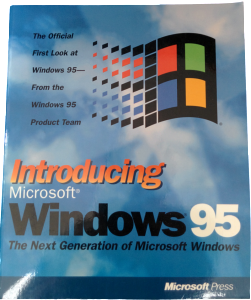 The year is 1995. AOL rules supreme as the internet service provider of choice, and Microsoft has just released a new operating system called Windows 95, a replacement for Windows 3.11. Personal computers were few, and far between, and those few people had were treated like gold. And, for good reason. A top of the line Compaq computer with an 80286 processor, 8MB of RAM and a 100MB Hard Drive, a dial up modem and Windows 95 and a handful of applications like Borland WordPerfect could set you back an easy $2000 or more, especially if you went with a large, 17″ Full color CRT monitor with .33 DPI.
The year is 1995. AOL rules supreme as the internet service provider of choice, and Microsoft has just released a new operating system called Windows 95, a replacement for Windows 3.11. Personal computers were few, and far between, and those few people had were treated like gold. And, for good reason. A top of the line Compaq computer with an 80286 processor, 8MB of RAM and a 100MB Hard Drive, a dial up modem and Windows 95 and a handful of applications like Borland WordPerfect could set you back an easy $2000 or more, especially if you went with a large, 17″ Full color CRT monitor with .33 DPI.
The Information Highway
Now, as revolutionary as Windows 95 was, it was something embedded in Windows 95 that would really turn the world on its ear. You see, this forefront leader in the technology world had seen the future, and it was going to be ruled by this very new thing called “The Information Highway” Very few people knew what the internet or World Wide Web was, let alone had any clue of its origins in DARPA, and, certainly, no-one knew what it would become. Back then, those few true internet fans were dialing up, enduring the squaking sounds, and pursuing ever baster baud rates while chatting with friends on bulletin board systems (BBS were the effectively original “online forum.”). But Microsoft knew, and if there’s anything that Microsoft has accomplished, it has been to put usable computers into the hands of the general public. To that end, Microsoft knew that the Internet could flourish only if people could reach it, and use it, and few people who walked into a computer store and paid $2000 or more for a PC were willing to spend still another $50 for Netscape Navigator just so they could pay yet another $9.95 for a measly 5 hours of online access at 9600-28800 bits per second (compared to today’s 1.5 million bits per second bottom of the line broadband internet) while tying up their only in house phone line. But, if the ability to surf the internet was already on the computer, for FREE, then, maybe people would start to wonder what it was. And so, stunning the world, Microsoft included something called Internet Explorer IN their installation of Windows 95. And they hooked it to as much of the operating system as they could. Help files launched Internet Explorer to display information, updated content could only be obtained through an internet connection. But that wasn’t the end of it. No, Microsoft took it one step further and announced that Internet Explorer would be —- FOREVER FREE!
Casualties of a Revolution
And so it began. With that announcement, Microsoft cut the feet right out from underneath one of the most popular browser of the time, Netscape Navigator, by changing the landscape of Internet Browsers from being a program that you paid for, to something that was your right to have, free of charge. Now, for Microsoft, even Apple, this was a cost that could be easily absorbed. But for Netscape, a company that paid its employees (including programmers, receptionists, help desk staff, owners etc) with the money from sales of their products, the ability to compete with a product that was readily available for free (and, in some cases, better than their own product), it spelled the end – casualties of a revolution. But they would not go down easy.
Justice Department Weighs In
In fact, the announcement also laid the path for another significant event : a 1998 justice department antitrust investigation that alleged “Microsoft set a zero price for its browser for the purpose of depriving Netscape of revenue and protecting its operating system monopoly.” As part of its defense, Microsoft reported that Internet Explorer was, in fact, “part of the operating system.” The intent of including an internet browser into the operating system was for the operating system (Windows) to be “the gateway to the information highway.”
“The Internet provides an incredible opportunity for Microsoft to effectively explore large-scale networks from many levels: customer needs, technical challenges, quality-of-service issues, electronic commerce and information-browsing technologies.” – J Allard, 1994
The justice department suit dragged on for more than a decade, a veritable eon in the rapidly changing landscape of technology, and was finally settled on May 12, 2011 with the expiration of a consent decree that :
 Introducing Microsoft Edge in Windows 10
Introducing Microsoft Edge in Windows 10
Of course, the expiration of the consent decree arrived well after the emergence of another technological powerhouse – Google, whose search engine revolutionized the internet, paving the way for the distribution of another well known free browser – Google Chrome, and its internet capable Chrome Operating System. Along the way, other free internet browsers have also sprung up, including Apple’s Safari, Mozilla’s Firefox, and Opera Software’s Opera browser. But the significance of the expiration is that it finally freed Microsoft to pursue their original mission – to make “Windows the gateway to the information highway;” which brings us, at along last, to Windows 10, which will include Microsoft Edge – the replacement for Internet Explorer.
Wait – What about My Internet Explorer!?
Now, this doesn’t mean that you will wake up tomorrow to find Internet Explorer suddenly no longer works, or that your core critical business application is going to have to be replaced tomorrow. Microsoft has a good track record of providing backwards compatibility in all of its core products. It does, however, put the world on notice : It’s not 1990 anymore, and the world of computing technology is a very different place. So, dust off your old list of computer technicians, consultants and programmers, call them and ask them to start looking into how this is going to change your business, so that you are prepared for what is to come. And, while you wait, kick back, and enjoy whatever browser you are using, and remember – you can thank Microsoft Internet Explorer for ushering in a new era of infinite Internet possibilities.
